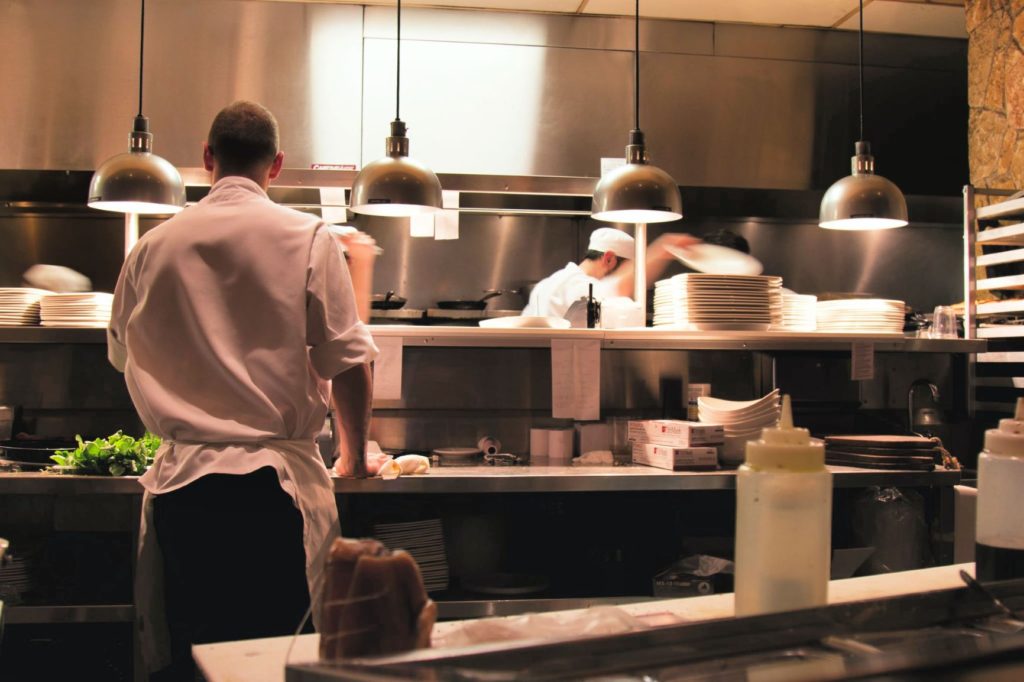I don’t know about you but when it comes to food two things have happened for me during this pandemic: (1) I have been cooking more and have started trying to eat healthier and lose some weight. And (2) I am tired of being in the house and miss going out to eat.
But here’s the thing about going out to eat – I almost never make healthy menu choices at a restaurant. It’s like I go into this alternate universe and think that I deserve whatever I want because someone else is cooking it. And let’s face it, that is part of the fun of going out to eat. When you are in a restaurant someone else is cooking and cleaning, and they are serving things you would not normally have at home (cheesecake, or fried cheese sticks anyone?). And that bread, what?! Anyway, I digress.
Eating out is a great treat once in a while, but a restaurant’s aim is to make food look, smell, and taste great so that they can make money. Nutrition may get pushed aside in favor of butter, rich sauces, creamy dressings, and sugar. The fat, calories, sugar, and sodium can really add up quickly if you eat out regularly.
But there is good news! You can still enjoy going out to eat and also eat healthy foods. You can both eat healthy and socialize in a restaurant with just a few small changes. Here are my 10 best tips for eating out while also sticking to a healthy diet.
1. Plan Ahead
Sometimes eating out is something we decide to do on the spur of the moment, usually when I forgot to thaw something out the night before or when I am just too tired to think about cooking (in other words hangry). But if you are able to plan ahead for your dinner or social activity at a restaurant that will make eating healthy much easier.
First, you can preview the menu online. Nowadays many restaurants even have nutrition information available online as well. Besides the menu choices you may learn other helpful things about the restaurant through their website. Information such as where their food comes from, how they prepare it, and the restaurant’s overall philosophy can be eye opening. That way when you arrive at the restaurant you will already have a plan in mind and won’t be as distracted by the menu pictures or appetizer specials.
Next, try to order first when possible. Other people can subconsciously influence your decisions without you really noticing. That way your “plan” will not get sidetracked when you hear what others are ordering. Try to stick to your original plan, and don’t change your mind when you get there.
The sight and smell of certain foods can make it more difficult to stick to your plan, especially if you are hungry. But picking out what you will order before you arrive makes it easier to avoid making snap decisions you might regret later.
2. Make sure you are drinking enough water.

This may sound like a weird tip for healthy eating at a restaurant, but staying hydrated can keep you from feeling as hungry. In fact, sometimes when we think our brain is telling us that we are hungry we are actually thirsty, not hungry.
I have been trying to drink more water and less caffeine lately, and it is making a difference. When you are in a restaurant order a glass of water and keep it filled. Drink lots of water before, during, and after your meal. Make sure you are hydrated, then your mind will not trick you into eating more food when it was really water your body needed.
One study showed that people on a diet who drank 500 ml (about 16 oz.) of water half an hour before a meal ate fewer calories and lost more weight than those who didn’t.
The next time you feel hungry at home try drinking a couple of glasses of water. Then wait about 15 minutes before you eat anything. You will either not feel hungry anymore or not as hungry. If it works at home it will work out at a restaurant too.
3. Have a snack before you go.
Have you ever gone to the grocery store hungry? What’s worse is going shopping on payday while hungry. You end up coming home with all sort of things that were not on your grocery list. Well, the same principle applies when you go out to eat or to a party or other social gathering where there is food. If you are super hungry when you get there you will want to eat everything in sight.
Before you go out to eat try eating a healthy snack at home first. Choose a snack that is rich in fiber, protein, and healthy fats. Try a hard boiled egg, a handful of nuts, veggies, yoghurt, or half of a protein shake. That way you are not getting that sinking feeling on the way to the restaurant and end up ordering every unhealthy thing that sounds good when you get there.
If you know you are going to eat at a favorite restaurant for dinner, eat a lighter lunch that day then a snack right before you go.
4. Ask how the food is prepared.

Don’t be afraid to ask questions of the staff at a restaurant. Their job is to make sure you have a good experience. Ask your server how the food is prepared. Sometimes even when a dish sounds healthy it can have many hidden salt, oils, sauces, and even sugar that is not obvious from the menu. Once you have this knowledge you can request substitutions or adjustments for how you want the meal to be prepared.
Instead of frying, opt for steaming, broiling, baking, or roasting. Foods described on the menu as creamy, pan-fried, crispy, crunchy, or sauteed will usually have more fat and calories. Ask for a small amount of olive oil to be used instead of fattening oils.
You can also ask for dressings, sauces and seasonings on the side so that you can control the amount you want to use. Cream sauces should be kept to a minimum, so look carefully at a dish’s ingredients or ask your server exactly how it is prepared.
5. Manage your portions.

Keep your portions small. Restaurants typically serve bigger portions than what would be considered a normal serving size, sometimes as much as four times more than what most healthy adults need in one sitting. It is usually more than what you would eat at home too. And by all means skip the all-you-can-eat buffets!
Ask for half portions or ask for a box with your meal. I like to ask for a box as soon as I place my order. Before you eat any of your food, box up half of it to take home for later. Or try splitting a meal with a friend. And be careful. In some places even half may be too much. Sometimes an appetizer portion or a side dish is all that you need.
Do you belong to the “clean plate club?” Maybe you grew up in a family environment where you were taught to clean your plate before you could be excused from the table or you were encouraged to eat everything on the plate because leaving food was wasteful (cue the “there are starving children in other parts of the world” line). I get it. But it is okay to just immediately divide your meal into what you’ll eat at the restaurant and everything else that goes in the box. You will make your co-workers jealous when they see you with leftover”restaurant food” the next day at lunch.
6. Eat more vegetables.

I am trying to learn to eat more vegetables at home, but this is especially important in restaurants. Besides all the vitamins, the fiber in vegetables keeps us full longer. This keeps your blood sugar more even and can prevent you from overeating. Try ordering a hearty vegetable soup like minestrone for an appetizer. Order a vegetable and salad instead of potatoes or pasta as a side dish. Ask for extra veggie toppings on wraps, pizzas, burgers, and sandwiches.
Find something on the menu that’s rich in vegetables and protein. This is the best combination for good blood sugar balance, which regulates your hunger hormones, how full you feel, your energy level, and your digestion. The U.S. government’s dietary guidelines say that half of our plate should be made up of fruits and vegetables daily.
Skip the bread basket and try ordering a salad or broth based vegetable soup first. Eating the salad first gives you the fiber to make you feel full and also helps you stave off the bread basket temptation. Make sure to ask for the dressing on the side, and opt for olive oil based salad dressings instead of the creamy ones.

For example, I love ranch dressing, but just two tablespoons of it adds an extra 140 caloriesand 16 grams of fat to my meal. Yikes! A serving of salad dressing is about two tablespoons, but most restaurants tend to double that in order to coat everything in the salad and boost the flavor.
But be careful with salads. Restaurants like to add tasty toppings such as croutons, cheese, seeds, nuts, and dried cranberries that can end up having more calories than if you ate a bowl of pasta. Just ask for all toppings to be served on the side. That way you can pick and choose what you want to add and how much.
Instead of focusing on what you can’t have, focus on what healthy foods you can add to your plate. Lean meat, veggies, whole grains, and fruits can be delicious options if prepared properly. Think about choices like a chicken and vegetable kabob.
7. Go for whole grains.

If given a choice, look for dishes made with whole grains such as brown rice, oats, barley, or quinoa. Whole wheat or whole grain buns, tortilla wraps, pasta, or pizza crust are better choices than those made with white flour. Studies have shown that whole grains actually increase metabolism, which helps you lose weight.
8. Watch your beverages.
The best choice for a beverage is always water, but if that is not enough for you make sure your alcoholic drinks are not mixed with syrups and sugar. Limit or avoid soda and sweet tea, as they are full of pure sugar. I do not always follow this advice, but make it simple and order water. It is free and you have more calories left for your food.
9. Skip dessert
Wait! Hear me out. Restaurant desserts look and sound so good on the menu, but they can sometimes have as much or more calories than your your entire meal! If it fits in your diet, and you have a healthy relationship with food then maybe you can split dessert with someone else.
If you feel that you must have something extra after dinner try skipping dessert and ordering coffee instead. Or wait until you get home and choose a lower calorie sherbet or yoghurt at home.
10. Take your time.
Have you ever heard of mindful eating? Recently I have started logging my meals, and it has forced me to stop and be aware of what all I am putting in my mouth. So many times we just wolf our food down without even stopping to really taste it or think about how much we are eating.
Instead, try pausing in between bites. Each time you take a bite of food, casually put your fork down on the plate and rest until you have fully chewed your food and swallowed. I know it sounds weird, but it makes sense. Chewing your food thoroughly and eating more slowly helps you eat less and makes you feel full more quickly.
Pausing helps you pace yourself. Your digestive system takes about 20 minutes to send the signal to your brain that you are full. If you eat until you feel full, then you were probably actually full 15 – 20 minutes earlier. This mind-body awareness keeps you in the moment spending time with others and positively impacts your eating behavior.
Really try to enjoy your food one bite at a time. You can’t truly taste your food if you are eating too quickly. Fast eaters tend to also be overeaters. If you eat slowly and mindfully, you will eat less and still be satisfied.
Enjoy your restaurant experience!
If you like dining out, don’t think you have to stop just because you want to get healthier. With these tips and a little planning, you can order meals that you love that are also nutritious. Remember you always have a choice. You do not have to choose health over taste. Keep your heart and body healthy by making good lifestyle choices work wherever you are. Bon appetit!

